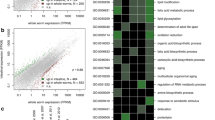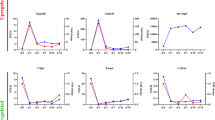Abstract
Gastrointestinal nematodes of the genus Cooperia are arguably the most important parasites of cattle. The bovine jejunal transcriptome was characterized in response to Cooperia oncophora infection using RNA-seq technology. Approximately 71% of the 25,670 bovine genes were detected in the jejunal transcriptome. However, 16,552 genes were expressed in all samples tested, probably representing the core component of the transcriptome. Twenty of the most abundant genes accounted for 12.7% of the sequences from the transcriptome. A 164-h infection seemingly induced a minor change in the transcriptome (162 genes). Additionally, a total of 162,412 splice junctions were identified. Among them, 1,164 appeared unique to 1 of the 2 groups: 868 splice junctions were observed only in infected animals, while 278 were only present in all 4 control animals. Biological functions associated with muscle contraction were predominant Gene Ontology terms enriched in the genes differentially expressed by infection. The primary function of two of the four regulatory networks impacted was related to skeletal and muscular systems. A total of 34 pathways were significantly impacted by infection. Several pathways were directly related to host immune responses, such as acute phase response, leukocyte extravasation, and antigen presentation, consistent with previous findings. Calcium signaling and actin cytoskeleton signaling were among the pathways most significantly impacted by infection in the bovine jejunum. Together, these data suggest that smooth muscle hypercontractility may be initiated as a result of a primary C. oncophora infection, which may represent a mechanism for host responses in the jejunum during nematode infection.


Similar content being viewed by others
References
Antignano F, Mullaly SC, Burrows K, Zaph C (2011) Trichuris muris infection: a model of type 2 immunity and inflammation in the gut. J Vis Exp. doi:10.3791/2774
Carabeo RA, Grieshaber SS, Fischer E, Hackstadt T (2002) Chlamydia trachomatis induces remodeling of the actin cytoskeleton during attachment and entry into HeLa cells. Infect Immun 70:3793–3803
Coop RL, Sykes AR, Angus KW (1979) The pathogenicity of daily intakes of Cooperia oncophora larvae in growing calves. Vet Parasitol 5:261–269
Forney JR, DeWald DB, Yang S, Speer CA, Healey MC (1999) A role for host phosphoinositide 3-kinase and cytoskeletal remodeling during Cryptosporidium parvum infection. Infect Immun 67:844–852
Frenal K, Soldati-Favre D (2009) Role of the parasite and host cytoskeleton in apicomplexa parasitism. Cell Host Microbe 5:602–611
Gasbarre LC, Stout WL, Leighton EA (2001) Gastrointestinal nematodes of cattle in the northeastern US: results of a producer survey. Vet Parasitol 101:29–44
Gasbarre LC, Smith LL, Hoberg E, Pilitt PA (2009) Further characterization of a cattle nematode population with demonstrated resistance to current anthelmintics. Vet Parasitol 166:275–280
Kanobana K, Vervelde L, Van Der Veer M, Eysker M, Ploeger HW (2001) Characterization of host responder types after a single Cooperia oncophora infection: kinetics of the systemic immune response. Parasite Immunol 23:641–653
Kanobana K, Ploeger HW, Vervelde L (2002) Immune expulsion of the trichostrongylid Cooperia oncophora is associated with increased eosinophilia and mucosal IgA. Int J Parasitol 32:1389–1398
Kanobana K, Koets A, Bakker N, Ploeger HW, Vervelde L (2003a) T-cell mediated immune responses in calves primary-infected or re-infected with Cooperia oncophora: similar effector cells but different timing. Int J Parasitol 33:1503–1514
Kanobana K, Koets A, Kooyman FN, Bakker N, Ploeger HW, Vervelde L (2003b) B cells and antibody response in calves primary-infected or re-infected with Cooperia oncophora: influence of priming dose and host responder types. Int J Parasitol 33:1487–1502
Khan WI, Collins SM (2004) Immune-mediated alteration in gut physiology and its role in host defence in nematode infection. Parasite Immunol 26:319–326
Li RW, Gasbarre LC (2009) A temporal shift in regulatory networks and pathways in the bovine small intestine during Cooperia oncophora infection. Int J Parasitol 39:813–824
Li RW, Sonstegard TS, Van Tassell CP, Gasbarre LC (2007) Local inflammation as a possible mechanism of resistance to gastrointestinal nematodes in Angus heifers. Vet Parasitol 145:100–107
Li L, Li X, Yan J (2008) Alterations of concentrations of calcium and arachidonic acid and agglutinations of microfilaments in host cells during Toxoplasma gondii invasion. Vet Parasitol 157:21–33
Li RW, Li C, Gasbarre LC (2011a) The vitamin D receptor and inducible nitric oxide synthase associated pathways in acquired resistance to Cooperia oncophora infection in cattle. Vet Res 42:48
Li RW, Rinaldi M, Capuco AV (2011b) Characterization of the abomasal transcriptome for mechanisms of resistance to gastrointestinal nematodes in cattle. Vet Res 42:114. doi:10.1186/1297-9716-42-114
Masek KS, Fiore J, Leitges M, Yan SF, Freedman BD, Hunter CA (2006) Host cell Ca2+ and protein kinase C regulate innate recognition of Toxoplasma gondii. J Cell Sci 119:4565–4573
Moran CM, Garriock RJ, Miller MK, Heimark RL, Gregorio CC, Krieg PA (2008) Expression of the fast twitch troponin complex, fTnT, fTnI and fTnC, in vascular smooth muscle. Cell Motil Cytoskeleton 65:652–661
Mortazavi A, Williams BA, McCue K, Schaeffer L, Wold B (2008) Mapping and quantifying mammalian transcriptomes by RNA-Seq. Nat Methods 5:621–628. doi:10.1038/nmeth.1226
Robinson MD, Oshlack A (2010) A scaling normalization method for differential expression analysis of RNA-seq data. Genome Biol 11:R25
Robinson MD, McCarthy DJ, Smyth GK (2010) edgeR: a Bioconductor package for differential expression analysis of digital gene expression data. Bioinformatics 26:139–140
Roffers-Agarwal J, Xanthos JB, Miller JR (2005) Regulation of actin cytoskeleton architecture by Eps8 and Abi1. BMC Cell Biol 6:36
Stebbins CE (2004) Structural insights into bacterial modulation of the host cytoskeleton. Curr Opin Struct Biol 14:731–740
Stromberg BE, Gasbarre LC, Waite A, Bechtol DT, Brown MS, Robinson NA, Olson EJ, Newcomb H (2011) Cooperia punctata: effect on cattle productivity? Vet Parasitol (in press)
Vallance BA, Blennerhassett PA, Collins SM (1997) Increased intestinal muscle contractility and worm expulsion in nematode-infected mice. Am J Physiol 272:G321–G327
Velculescu VE, Madden SL, Zhang L, Lash AE, Yu J, Rago C, Lal A, Wang CJ, Beaudry GA, Ciriello KM, Cook BP, Dufault MR, Ferguson AT, Gao Y, He TC, Hermeking H, Hiraldo SK, Hwang PM, Lopez MA, Luderer HF, Mathews B, Petroziello JM, Polyak K, Zawel L, Kinzler KW et al (1999) Analysis of human transcriptomes. Nat Genet 23:387–388
Weisbrodt NW, Lai M, Bowers RL, Harari Y, Castro GA (1994) Structural and molecular changes in intestinal smooth muscle induced by Trichinella spiralis infection. Am J Physiol 266:G856–G862
Wu TD, Nacu S (2010) Fast and SNP-tolerant detection of complex variants and splicing in short reads. Bioinformatics 26:873–881
Acknowledgements
The author would like to thank Drs. Louis Gasbarre and Tad Sonstegard for their kind support. Gratitude is also extended to Alicia Beavers, Ashley Sperling, Debbie Hebert, and Joanne Wilson for their excellent technical assistance. Mention of trade names or commercial products in this publication is solely for the purpose of providing specific information and does not imply recommendation or endorsement by the US Department of Agriculture (USDA). The USDA is an equal opportunity provider and employer.
Author information
Authors and Affiliations
Corresponding author
Rights and permissions
About this article
Cite this article
Li, R.W., Schroeder, S.G. Cytoskeleton remodeling and alterations in smooth muscle contractility in the bovine jejunum during nematode infection. Funct Integr Genomics 12, 35–44 (2012). https://doi.org/10.1007/s10142-011-0259-7
Received:
Revised:
Accepted:
Published:
Issue Date:
DOI: https://doi.org/10.1007/s10142-011-0259-7




